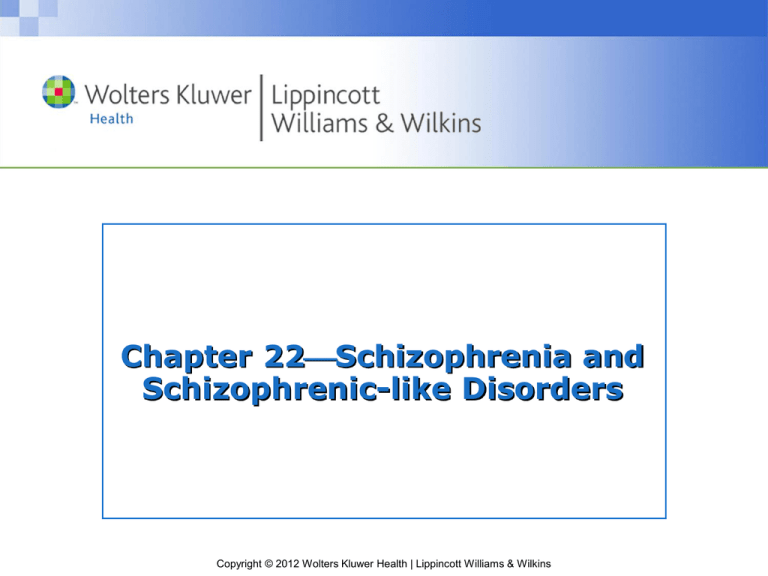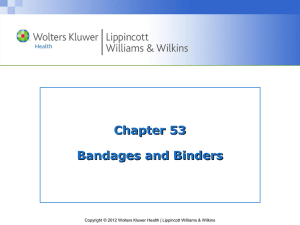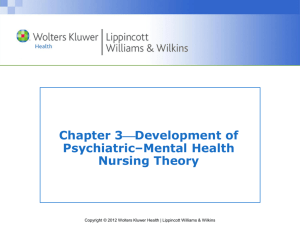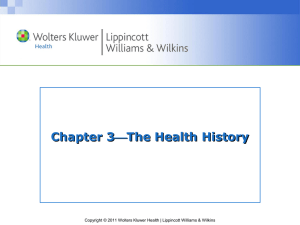Chapter 22
advertisement

Chapter 22Schizophrenia and Schizophrenic-like Disorders Copyright © 2012 Wolters Kluwer Health | Lippincott Williams & Wilkins The burden of psychiatric conditions has been heavily underestimated. Disability caused by active psychosis in schizophrenia produces disability equal to quadriplegia. National Institute of Mental Health, 2001 Copyright © 2012 Wolters Kluwer Health | Lippincott Williams & Wilkins Learning Objectives • Compare at least three current theories contributing to the understanding of the development of schizophrenia • Articulate the classification of the five phases of schizophrenia • Differentiate the positive, negative, and disorganized symptoms of schizophrenia • Distinguish the five subtypes of schizophrenia • Understand why cultural differences should be considered when assessing clinical symptoms in clients with suspected psychotic disorders • Analyze why an antidepressant drug and an atypical antipsychotic agent may be necessary to stabilize the clinical symptoms of schizophrenia Copyright © 2012 Wolters Kluwer Health | Lippincott Williams & Wilkins Learning Objectives (cont.) • Articulate the criteria that indicate the presence of metabolic syndrome • Recognize the importance of assessing for the presence of psychogenic polydipsia • Explain the terms awareness syndrome or awakening phenomena • Discuss why a client with the diagnosis of schizophrenia may develop treatment-resistant symptoms • Compare and contrast the rationale for the use of the following interactive therapies generally effective when providing care for clients with schizophrenia: group therapy, cognitive–behavioral therapy, and personal therapy Copyright © 2012 Wolters Kluwer Health | Lippincott Williams & Wilkins Learning Objectives (cont.) • Discuss the purpose of including the client and family in multidisciplinary treatment team meetings • Comprehend the importance of continuum of care for clients with schizophrenia • Construct therapeutic nursing interventions when planning care for a client with the diagnosis of schizophrenia, paranoid type Copyright © 2012 Wolters Kluwer Health | Lippincott Williams & Wilkins Schizophrenia • Schizophrenia is considered the most common and disabling of the psychotic disorders. Although it is a psychiatric disorder, it stems from a physiological malfunctioning of the brain. • This disorder affects all races and is more prevalent in men than in women. Copyright © 2012 Wolters Kluwer Health | Lippincott Williams & Wilkins Onset of Schizophrenia • The onset of schizophrenia may occur late in adolescence or early in adulthood, usually before the age of 30. Although the disorder has been diagnosed in children, approximately 75% of persons diagnosed as having schizophrenia develop the clinical symptoms between the ages of 16 and 25. Copyright © 2012 Wolters Kluwer Health | Lippincott Williams & Wilkins Etiology of Schizophrenia • Genetic predisposition theory • Biochemical and neurostructural theory • Organic or psychophysiologic theory • Environmental or cultural theory • Developmental theory • Psychological or experiential theory • Vitamin deficiency theory Copyright © 2012 Wolters Kluwer Health | Lippincott Williams & Wilkins Dopamine Receptors (The Dopamine Hypothesis) Copyright © 2012 Wolters Kluwer Health | Lippincott Williams & Wilkins Clinical Symptoms and Diagnostic Characteristics • Positive symptoms – Overt psychotic or distorted behavior – Hallucinations – Delusions – Suspiciousness • Negative symptoms – Diminution or loss of normal functions – Flat or blunted affect – Poor motivation – Inability to enjoy activities • Disorganized symptoms – Confused thinking – Incoherent or disorganized speech – Disorganized behavior Copyright © 2012 Wolters Kluwer Health | Lippincott Williams & Wilkins Clinical Symptoms and Diagnostic Characteristics (cont.) • Paranoid type • Catatonic type • Disorganized type • Undifferentiated type • Residual type Copyright © 2012 Wolters Kluwer Health | Lippincott Williams & Wilkins Schizophrenic-Like Disorders • Schizoaffective disorder • Schizophreniform disorder • Brief psychotic disorder • Psychotic disorder due to a general medical condition Copyright © 2012 Wolters Kluwer Health | Lippincott Williams & Wilkins The Nursing Process • Assessment • Nursing diagnoses • Outcome identification • Planning interventions • Implementation • Evaluation Copyright © 2012 Wolters Kluwer Health | Lippincott Williams & Wilkins Assessment • Presence or absence of clinical symptoms • History and physical examination • Transcultural considerations Copyright © 2012 Wolters Kluwer Health | Lippincott Williams & Wilkins Nursing Diagnoses • Disturbed thought processes • Disturbed sensory perception • Self-care deficit • Impaired verbal communication • Noncompliance • Disturbed sleep pattern • Social isolation • Ineffective coping Copyright © 2012 Wolters Kluwer Health | Lippincott Williams & Wilkins Outcome Identification Outcomes are influenced by several factors: • The client’s present coping strategies and level of cognitive function • The presence or absence of support systems • The presence or absence of adequate income • The clinical setting in which each treatment occurs Copyright © 2012 Wolters Kluwer Health | Lippincott Williams & Wilkins Planning Interventions Interventions planned may include the following: • Medical interventions • Diagnostic studies • Medication • Cognitive therapy • Behavioral techniques • Other supportive therapies • Electroconvulsive therapy Copyright © 2012 Wolters Kluwer Health | Lippincott Williams & Wilkins Implementation • Assistance in meeting basic needs • Medication management • Interactive therapies • Psychosocial therapies • Client and family education Copyright © 2012 Wolters Kluwer Health | Lippincott Williams & Wilkins Evaluation • Compare the client’s current mental status with stated desirable outcomes identified. • If the outcomes have not been met, consider the reasons why. Copyright © 2012 Wolters Kluwer Health | Lippincott Williams & Wilkins Key Terms • Affective disturbance • Echolalia • Ambivalence • Echopraxia • Autistic thinking • Looseness of association • Awakening phenomena • Negative symptoms • Awareness syndrome • Pica • Dementia praecox • Positive symptoms • Disorganized symptoms • Psychogenic polydipsia • Dopamine hypothesis • Schizophrenia • Double-bind situation Copyright © 2012 Wolters Kluwer Health | Lippincott Williams & Wilkins Reflection Reread the chapter-opening quote. • In what manner does active psychosis in schizophrenia produce disability equal to quadriplegia? Cite two or three examples to substantiate your explanation. • How would these examples of disability affect the family of a client with schizophrenia? Identify what support systems the family and the client could use. ? Copyright © 2012 Wolters Kluwer Health | Lippincott Williams & Wilkins






